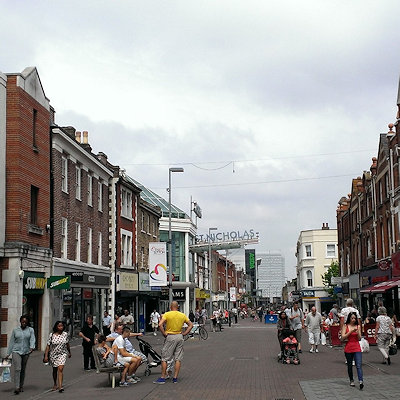
Like us on Facebook
PLACE NAMES


 
|
|
Sutton
|

|
|
|
The placename Sutton is recorded in the 1086 Domesday Book as Sudtone. It is formed from Old English 'suth' and 'tun', meaning 'the south enclosure or farm'. It was probably in relation to Mitcham and Morden that it was considered southerly. The name was later applied to Sutton Common and the Sutton New Town development in the 19th century.
Archaeological finds in the region date back over ten thousand years, but the first substantial evidence of habitation comes from the excavation of a Roman villa in Beddington. An implement from the neolithic age was discovered close to the junction of Sutton High Street and Carshalton Road. The Roman road of Stane Street forms part of the northern boundary of the parish of Sutton. The course of Stane Street through the area is now followed by the modern roads Stonecot Hill and London Road, and designated A24 on road maps.
Sutton was recorded as Sudtone in a charter of Chertsey Abbey believed to have been drawn up in the late seventh century when the Manor was granted to the Abbot of Chertsey by Frithwald, Governor of Surrey. Some sources state the early name as Suthtone or Sudtana instead. Other place names that appear in this charter are Bedintone (Beddington), Cegeham (Cheam), and Aeweltone (Carshalton).
The Domesday Book states that Sutton was about 800 acres in size, and had about 30 houses and a population of about 200. It also states that the Abbot of Chertsey held the Manor. In 1145 the Prior of Merton had vineyards in Sutton. In 1538 the Manor was sold to King Henry VIII and granted to Sir Nicholas Carew of Beddington. When Sir Nicholas was sentenced to death for treason, the King seized the manor. Queen Mary later restored it to Francis, son of Sir Nicholas Carew. The Manor later became a Crown possession again until King Charles II granted it to the Duke of Portland in 1663, who sold it in 1669 to Sir Robert Long, who sold it that year to Sir Richard Mason. The Manor sold almost all of its land and has regularly changed hands since.
From the time of Domesday until the 19th-century establishment of local government and disestablishment of hundred courts, Sutton formed a parish in the Wallington hundred of Surrey, in the feudal system. However, by the time of Richard II, the parish was exempt from paying feudal dues at the Hundred Court.
Sutton's location on the London to Brighton turnpike from 1755 led to the establishment of coaching inns, spurring its further development as a village. When it was connected to central London by rail in 1847, the village began to grow into a town, and there was significant Victorian-era expansion. Sutton's expansion and increase in population accelerated in the 20th century as part of the suburban growth of London. It became a municipal borough with neighbouring Cheam in 1934, and has formed part of Greater London since 1965.
Sutton has the largest library in the borough, several works of public art, four conservation areas and a park and green at either end of the high street. It is home to a number of large international companies and the sixth most important shopping area in London, centred on Sutton High Street. Sutton mainline railway station is the largest in the borough, with frequent services to central London and other destinations. Along with Wimbledon Studios, Sutton is a hub for filming in south-west London. Sutton is home to the Royal Marsden Hospital and the Institute of Cancer Research; there are plans to create the world's second biggest cancer research campus on the site. The town has among the lowest levels of crime in Greater London.
Sutton is home to a significant number of the borough's schools, within a borough which is among the top performing authorities for education in the country. In 2011 Sutton was the top performing borough for GCSE results in England.
|
 Feel free to Email me any additions or corrections Feel free to Email me any additions or corrections
LINKS AVAILABLE TO YOUR SITE
| |





